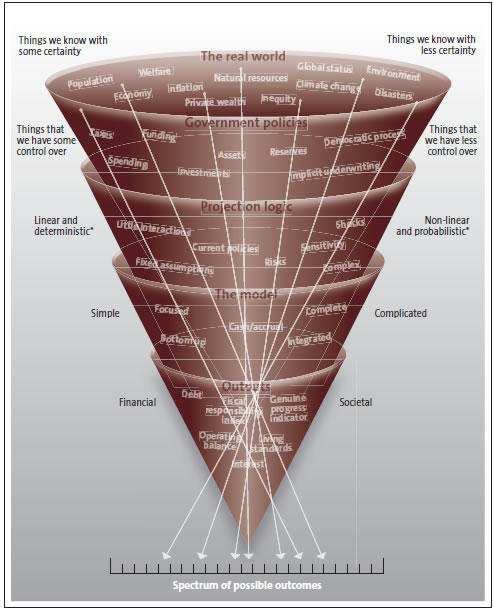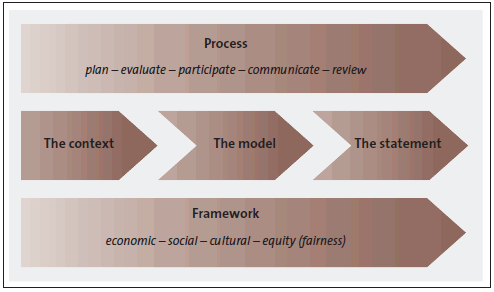Part 2: Background to long-term projections
2.1
In this Part, we discuss the background to long-term projections, the concept of financial sustainability, and the building blocks for reporting on long-term financial sustainability.
2.2
New Zealand, like many other countries, faces significant challenges arising from expected social, environmental, and economic changes. If the financial health of the Government were to worsen, the ability to continue to deal with these challenges would be reduced, and the financial situation could become unsustainable.
2.3
Preparing financial projections can help to:
- bring together and summarise the activities and elements of government;
- inform and encourage public discussion about policies and expectations;
- evaluate the robustness of policies and initiatives – before and after decisions are made;
- identify future uncertainties and risks for planning and management; and
- provide confidence about the resilience and sustainability of government.
2.4
Financial projections of government activities can never fully describe the real world. However, they are fundamental to understanding the strength or weakness of a government's future financial position.
Long-term financial sustainability
2.5
Two definitions of sustainability are the ability to maintain something at a certain rate or level (such as sustainable economic growth) and the ability to uphold or defend something (such as sustainable professional practices).9 We consider that public sector financial sustainability encompasses both these definitions, which are inextricably linked.
2.6
We consider that the main elements of public sector financial sustainability are:
- immediate solvency the ability to meet obligations when they fall due;
- resilience the capacity to withstand internal and external shocks;
- service and financial responsibility maintaining reasonable services, debt, and commitments relative to national expectations and likely future income; and
- public confidence the ultimate guarantor that enough revenue can be collected to meet future obligations.
2.7
In our recent discussion paper, Public sector financial sustainability, we describe financial sustainability as:
… the financial capacity of the public sector to meet its current obligations, to withstand shocks, and to maintain service, debt and commitments at reasonable levels, relative to both national expectations and likely future income, while maintaining public confidence.10
2.8
In that paper, we also suggested that indicators should consider social, environmental, and public sector non-financial factors, because these are the long-term drivers of demand for, and effective delivery of, public services.
2.9
Trends in all these areas will shape how government taxation, regulation, redistribution, and spending will change. For instance, changing demographics and New Zealand's ageing population are obvious ongoing drivers of expenditure under current policy. However, potentially negative changes in New Zealand's biocapacity and income equality could also have significant long-term effects.
2.10
Public sector financial sustainability emphasised the connections between these social, environmental, and economic indicators. It noted that long-term public sector financial sustainability is a complex, society-wide issue, requiring a wide range of perspectives and effective debate.
2.11
Figure 1 shows that any single financial projection simplifies a far more diverse reality.
Figure 1
How drivers of financial sustainability can affect government policies and approaches to projecting the financial consequences

*In simple terms, linear and deterministic means that the model's drivers are fixed and assumed to represent all possible states of the world. Non-linear and probabilistic means that randomness and complexity are also present.
2.12
Understanding the diversity (or degree of uncertainty) that surrounds a single financial projection is essential in explaining how well the projection reflects reality. Without this understanding, it is difficult to recognise and plan for unseen challenges and future opportunities.
Building blocks for reporting on long-term financial sustainability
2.13
Being able to knowledgeably explain what might happen in the long term requires at least three components:
- a good knowledge of where we are today, what the important matters are, and what will bring about change (the context);
- a way of projecting that starting point into the future using drivers of change and assumptions (the model); and
- a way of translating what the context and projection mean for the intended audience (the statement).
2.14
Figure 2 shows how these components fit together and shows the need for a co-ordinated process and framework.
Figure 2
Building blocks for reporting on long-term financial sustainability

9: See the Oxford Dictionaries website, http://oxforddictionaries.com.
10: Controller and Auditor-General (2013), Public sector financial sustainability, page 5.
page top
